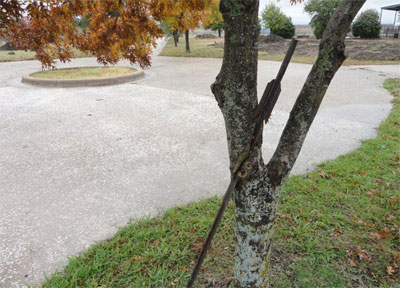Question and Answer – January 2012
If you’d like Neil Sperry’s input on a particular plant question, send it and a photo to him, then watch the next issue of e-gardens for his reply. Remember to give him your city, so that he can tailor his answer to you more specifically. He answers 6 or 7 questions each issue, concentrating on those of greatest general reader interest. Click here to send him your question AND photo.
Question: In visiting an old cemetery, I found this metal rod almost embedded in a tree. I can remove the metal not touching the tree, but should I cut into the tree to remove the rest of the metal piece? T., no city given.

Answer: You should be able to remove the entire stake fairly easily and cleanly. Since the tree has not grown completely around the metal, as it eventually would, you can take a sharpened 1-inch wood chisel and neatly and gently clean away the wood that covers the metal. It should pop right out after you’ve done that. Do get the cemetery manager’s permission before starting, of course.
Question: The brutal summer took a toll on our little rosemary plant. Should it be pruned to the ground, pruned selectively or left to whatever Mother Nature wants? S.S., Paris.

Answer: I’d suggest pruning it somewhere between "selectively" and "to the ground." I would remove all of the dead tissues. Then, I’d prune the remaining green stems to reshape the plant. Last winter probably started the decline. I really was amazed at how many of our Texas rosemary plants survived the two cold spells. The heat and drought added to their problems.
Question: About 15 years ago, I created a wildlife habitat here adjacent to Big Bend National Park. I planted four piñon pines. They have done very well for all the years until now. One looks really bad. There is so much sap coming out of its trunk. From what I can read on the Internet, it’s stress-related, and odds of saving the tree are small. Thoughts? I don’t want to keep hauling water trying to save it, if it’s just going to be for naught. C.O-J. Christmas Mountains.
Answer: I’m flattered to have a question from one of Texas’ most beautiful counties. Thank you. I’ll give it my best shot, but it’s going to involve your sending samples to the Plant Disease Diagnostic Laboratory at Texas A&M. They can culture bark and stem tissue to see if a pathogen is present. Sometimes, diseases come to the forefront when stresses take a toll on the health and well-being of pines. Much of the rest of Texas has seen Eldarica pines and Leyland cypresses struggle and die the past couple of years. In the case of Leyland cypress, Seriedium canker has attacked them, and it is also associated with heavy sap flow. The sap crystallizes on the trunk, just as you’re seeing on your pine. You might e-mail the lab at A&M to see what specific types of tissue samples they would need. Good luck! I hope I was of at least some help.
Question: I have a crape myrtle that had a population of white insects last summer. I tried Neem oil, but they were still there into the fall. I’m not sure if they’re dead or alive, or whether I should be treating with something else. D., Keller.

Answer: This is a scale insect that first appeared on crape myrtles in 2005. It was epidemic in 2007, but it’s been much less of a problem since. 2011 was not a generally bad year for it, but it obviously was for your plant. Here is a link to our website for The Crape Myrtle Trails of McKinney, specifically to the pest control page. (http://crapemyrtletrails.org/pest.html) Pay particular attention to the ladybugs that feed on these scale insects. They won’t be there now, but they are great at eliminating the pests, so don’t spray if you see ladybugs in warmer weather. You could also apply a horticultural (dormant) oil spray this winter. As you’ll see in the notes, we still have a great deal to learn about this pest and its control.
Question: I planted half of my yard in English ivy about 10 years ago. It has always struggled by the end of August, but it has always bounced back in the fall. Wherever it received full sunlight, it died. Now, I’m replacing it with Algerian ivy. Is this the same as your Persian ivy you used to sell? No name, no city given.

Answer: It’s the sunlight that’s killing the ivy, and it will kill English, Persian and Algerian ivies. The various hederas just aren’t equipped to grow in Texas’ hot summer sun. As an added concern, both Algerian and Persian ivy have leaves that are three times larger than those on English ivy, so they won’t match visually. Plus, Algerian ivy is hardy only in the southern third of Texas. You didn’t give your city, so I can’t be any more specific with my answer. Hope it helps.


